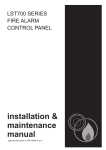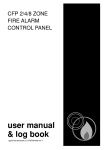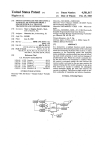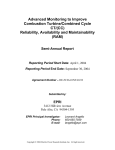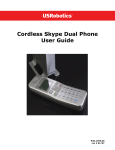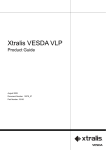Download ADEMCO LST700 Series User manual
Transcript
LST700 SERIES FIRE ALARM PANEL LST700 SERIES FIRE ALARM CONTROL PANEL user manual & log book approved document no. DFU7001003 rev 4 LST700 SERIES USER MANUAL • Approved Document No. DFU7001003 Rev 4 1 LST700 SERIES FIRE ALARM PANEL CONTENTS Safety ........................................................................................................................................ 3 Important information regarding the safe use of this fire alarm panel Fire Alarm Systems - An Overview ....................................................................................... 4 How fire alarm systems operate and a general overview of their key features System Maintenance ............................................................................................................... 5 General guidelines on what the user is expected to do Panel Layout / Accessing the Controls ................................................................................ 6 A summary of the controls and indicators available on this fire alarm panel, including:Control level definition How to access the panel’s secure user functions What the indicators mean Fire Conditions ....................................................................................................................... 8 How an alarm is indicated, and how to deal with it How to silence the alarm sounders How to manually activate the alarm sounders (i.e. to evacuate the building) How to reset a fire alarm condition Fault Conditions ..................................................................................................................... 9 The different types of fault that may occur, what they mean and how to deal with them Disablements ............................................................................................................................ 10 How to inhibit the functionality of certain parts of the fire alarm system Notes on Delays ....................................................................................................................... 12 Important information about delays, what they mean and what you should do about them System Set-Up Data Chart .................................................................................................... 13 Details of how the system has been set-up Log Book .................................................................................................................................. 14 A place for you to record details of events such as fires, false alarms, call outs, etc. Installation Certificate............................................................................................................. 19 © 2004. Errors & Omissions Excepted. The Manufacturer of this product operates a policy of continuous improvement and reserves the right to alter product specifications at its discretion and without prior notice. All of the instructions covered in this manual have been carefully checked prior to publication. However, no responsibility can be accepted by the Manufacturer for any inaccuracies or for any misinterpretation of an instruction or guidance note by the User. 2 LST700 SERIES USER MANUAL • Approved Document No. DFU7001003 Rev 4 LST700 SERIES FIRE ALARM PANEL SAFETY The fire alarm panel is safe to operate provided it has been installed in compliance with the manufacturers instructions and used in accordance with this manual. Do not operate the fire alarm panel with its enclosure open. There is no need to open the enclosure except to carry out commissioning, maintenance and remedial work. This work must only be carried out by competent service personnel who are fully conversant with the contents of the separate engineering manual for this product and have the necessary skills for maintaining this equipment. If the enclosure is damaged in any way, expert advice should be sought regarding its repair. Regular servicing of the fire alarm system is highly recommended, preferably on a continuous maintenance contract and by a competent organisation. A full-itemised report of the installation should be obtained at least annually. This product has been manufactured in conformance with the requirements of the Australian Communications Authority and all applicable EU Council Directives. N219 LST700 SERIES USER MANUAL • Approved Document No. DFU7001003 Rev 4 3 LST700 SERIES FIRE ALARM PANEL FIRE ALARM SYSTEMS - AN OVERVIEW The primary purpose of a fire alarm system is to provide early warning of a fire so that building occupants can be evacuated and action taken to stop the fire as soon as possible - all according to a predetermined plan. Alarms may be raised automatically, by smoke or heat detectors, or manually by a person operating a manual call point. To ensure an alarm is dealt with in an orderly manner, it is important to know where the alarm is coming from. To aid this function, fire alarm systems are usually split into zones, each covering a different area of a building. When an alarm has been raised, the fire alarm panel responds by indicating the zone in which the alarm has occurred and activating all relevant sounders, bells and other alarm outputs to provide a warning of the fire. Additional alarm outputs available on this fire alarm panel (which may or may not be used depending on the requirements of the site) are:■ A Remote Output: this output is automatically activated whenever the fire panel is in alarm and is returned to normal when the alarm sounders are silenced. ■ An Auxiliary Output: this output is activated when the panel is in alarm and is returned to normal when the panel is reset. It may be used to signal an alarm condition to other parts of the fire alarm system. If used, its function will be declared on the System Set-up Data Chart on page 13 of this user manual. This output may be disabled if required. The building’s fire management plan should always be executed when the fire alarm panel goes into alarm. See user responsibilities section on page 5 for further details. Fault monitoring For obvious reasons, the reliability of the fire alarm system is paramount. To this end, the fire alarm panel continuously monitors all connections between detectors, manual call points and sounders and also checks its own power supply and back-up batteries for faults. If a fault is detected anywhere on the system, the panel responds by illuminating one or more of the fault light(s) located on the front of its enclosure and sounding its internal fault buzzer. The panel’s fault output is also activated, sending notification of the fault (if connected) to a remote manned monitoring centre or other electronic equipment, as required. Delays Certain zones on a fire alarm system can be prone to conditions that lead to frequent and unavoidable false alarms, a common example being a waiting room filled with cigarette smoke. In areas such as these, it may be acceptable to delay the activation of the alarm sounders and other outputs to give a responsible person time to investigate the cause of the alarm. If the cause is found to be a true fire hazard, the delay can be overridden. In the event of a false alarm, the panel can be reset. Should the delay period expire without any user intervention, the alarm sounders will automatically sound to evacuate the premises. To ascertain if any delays have been programmed into the panel, refer to the System Set-up Data Chart on page 13. Disablements In abnormal conditions, certain parts of the fire alarm system can be temporarily turned off (disabled) to suit prevailing conditions. For example, if there is a risk of a false alarm occurring in a zone, say from vehicle exhaust smoke in a loading bay, it is possible to disable that zone during the risk period, then enable it again afterwards. Another example is the disablement of outputs during a routine test or temporary fault. Coincidence This feature should only be used where it is acceptable to the Authority Having Jurisdiction. The function is intended to control the effects of a false alarm but only when this is likely to have a significant impact, such as the activation of fire suppression systems. 4 LST700 SERIES USER MANUAL • Approved Document No. DFU7001003 Rev 4 LST700 SERIES FIRE ALARM PANEL SYSTEM MAINTENANCE AS1670.1 - 2004 Fire Detection Systems design, installation and commissioning and AS18551.8 set out criteria to ensure that systems are correctly placed into service and then maintained in a fully operational state. At the end of this manual we have included an Installer ’s Statement and Commissioning Report which should be completed for each system. These documents provide essential information which will assist with the ongoing testing and maintenance of the installation. Highlighted below are key recommendations on steps which should be taken to ensure the installation is in a fully operational state at all times. User responsibilities: 1 2 Check the Fire Indicator Panel system weekly to ensure the system is free of faults and is capable of activation when an alarm is inititated. Refer to weekly testing below. Ensure arrangements are in place for the test, maintenance and regular servicing of the system. Important: AS1851.8 recommends weekly and monthly tests that should be carried out by the user/responsible person - please refer to the bottom of this page for further details. 3 4 5 6 7 8 9 Ensure the system log book is kept up to date by recording fire signals, fault signals, work on the system, etc, and make sure it is available for inspection at all times. Ensure that all relevant occupants of the protected premises are instructed in the proper use of the system. Take steps to limit the number of false alarms on the system. Ensure the effectiveness of the system is not impaired by ensuring there is a space of at least 500mm in all directions around and below every fire detector and that all manual call points are unobstructed and easy to see. Liaise with all relevant building engineers, decorators, etc., to ensure any changes to (or maintenance of), the building’s fabric does not compromise the protection given by the fire alarm system, create faults or false alarms. Ensure that any structural or occupancy changes planned for the building are done so with due and early consideration given to any changes that may be required to the fire system. Ensure that a selection of spare parts are held as appropriate within the premises. Routine weekly and monthly testing to be undertaken by the user/responsible person We recommend that the following tests are carried out at approximately the same time each week, during normal working hours:Note: It is essential any alarm receiving centre is contacted before and after these tests to avoid unwanted alarms and to confirm the fire signal is correctly received. • • • • • • Carry out an Indicator lamp test to check all zone lights show and the beeper sounds. Operate a manual call point or smoke/heat detector to test the fire alarm. Check that the alarm sounders operate. Reset the system by pressing the Silence/Activate Sounders button and Control Panel Reset button. Verify that no manual call points or smoke/heat detectors are obstructed in any way. Test a different zone each week using a different call point or detector so all are tested in rotation. Monthly attention: Ensure authorized service personnel verify the system’s standby power supply (or supplies) are in good working order. Quarterly and periodic inspection, testing, servicing and maintenance It is the user’s responsibility to ensure that an ongoing inspection and maintenance contract is in place to meet the requirments of AS1851.8. The work required must be carried out by a competent person with specialist knowledge of fire detection and alarm systems. The standard recognises this will normally be an outside specialist fire alarm servicing organization. Please note: It is good practice to inspect the system on an annual basis to confirm that it is in a fully operational state. This should include testing all sounders to ensure that they are providing the correct level of sound generation. Australian Standards require that detectors are fully tested at least every two years. However it is also essential to regularly identify and clean dirty detectors which are outside manufacturer specification. LST700 SERIES USER MANUAL • Approved Document No. DFU7001003 Rev 4 5 LST700 SERIES FIRE ALARM PANEL PANEL LAYOUT / ACCESSING THE CONTROLS 1 2 3 Silence Inter nal sounder Silence/Activate sounders 4 5 8 Fire Zones 2 3 4 5 6 7 8 1 2 3 4 5 6 7 8 fault output status remote output status Zone fault/disabled/test supply remote present output I 7 1 Contr ol Panel Reset Enable/ Disable 6 test accessed general disablement O Lamp test general power system repeater supply fault fault fault fault sounder auxiliary output status output delays status Two levels of control are available to the User(s) of this fire alarm panel - General User and Authorised User. 1. General User Controls (access level one) When the panel is in access level one, the indicator lights on the front of the enclosure give a comprehensive overview of the system’s current status. Any fire and fault conditions are clearly displayed, disablements highlighted and the status of all outputs reported. For detailed descriptions of what each indicator means, please refer to the table on the opposite page. The only functions that can be performed by the user when the panel is in access level one are:■ Muting the panel’s internal sounder by pressing the Silence Internal Sounder button; ■ Overriding any delays which may have been programmed into the panel by pressing the Silence / Activate Sounders button (only applicable when the panel is in alarm); or ■ Putting the panel into access level two (the Authorised User state) - see below. 2. Authorised User Controls (access level two) To avoid unauthorised changes to critical parts of the fire alarm system, controls such as silencing the sounders, resetting an alarm condition and implementing disablements are only accessible via a secure method of entry which puts the panel into access level two. To put the panel into access level two:Turn the key to the I position (please note the key cannot be removed when in this position). When the key is in the I position, the Accessed light will be lit steady to show the user that the controls are operative. To leave the access level two, turn the key back to the O position Details of how to use the Authorised User controls can be found on pages 8 to 11 of this User Manual. 6 LST700 SERIES USER MANUAL • Approved Document No. DFU7001003 Rev 4 LST700 SERIES FIRE ALARM PANEL What the Indicators mean The table below summarises the various indicators available on the Fire Alarm Panel and what they mean in their various States. The final column highlights the page(s) you should turn to for further information. INDICATOR (General Fire) Fire Zones STATUS OF LIGHT WHAT THIS MEANS FURTHER READING Flashing Red The Panel has detected a fire alarm condition or the Activate Sounders button has been pressed to evacuate the building Page 8 (Fire Conditions) Steady Red There is a silenced fire alarm condition on the system. Page 8 (Fire Conditions) Flashing Red A fire alarm condition has been detected on the zones which are flashing Page 8 (Fire Conditions) Steady Red There is a silenced fire alarm condition on the zones which are lit steady Page 8 (Fire Conditions) 1 to 8 Zone fault/disabled/test Flashing Yellow Faulty wiring has been detected on the zones (in sync. with the which are flashing 1 to 8 gen. fault indicator Flashing Yellow (in sync. with the Test indicator) Page 9 (Fault Conditions) The zones which are flashing are in test mode Steady Yellow The zones which are lit steady have been disabled Page 10 (Disablements) supply present Steady Green The panel is supplied with power Page 4 (Overview) remote output Steady Red The remote output has been activated Page 4 (Overview) test Flashing Yellow The panel is in test mode accessed Flashing Yellow The access code is in the process of being entered Page 6 (Accessing the Controls) Steady Yellow The panel is in access level two Page 6 (Accessing the Controls) general disablement Flashing Yellow The panel is in the disablement selection state Page 10 (Disablements) Steady Yellow Part of the system has been manually disabled and/or one or more of the fire zones have had a delay applied to them Page 10 (Disablements) Page 12 (Notes on Delays) Flashing Yellow Faulty wiring has been detected on the fault output’s transmission path Page 9 (Fault Conditions) Steady Yellow The fault output has been disabled Page 10 (Disablements) Flashing Yellow Faulty wiring has been detected on the remote output’s transmission path Page 9 (Fault Conditions) Steady Yellow The remote output has been disabled Page 10 (Disablements) general fault Flashing Yellow A fault has been detected on the system Page 9 (Fault Conditions) power supply fault Flashing Yellow The panel has detected a fault with its power supply, battery charger or back-up batteries Page 9 (Fault Conditions) fault output status remote output status system fault Flashing Yellow The panel has detected a microprocessor fault Page 9 (Fault Conditions) repeater fault Flashing Yellow The panel has detected a wiring/communication fault on the repeater network Page 9 (Fault Conditions) sounder status Flashing Yellow Faulty wiring has been detected on the panel’s sounder circuits Page 9 (Fault Conditions) Steady Yellow The alarm sounders have been disabled Page 10 (Disablements) auxiliary output status Steady Yellow The panel’s auxiliary output has been disabled Page 10 (Disablements) Flashing Yellow Faulty wiring has been detected on the auxiliary output’s transmission path Page 9 (Fault Conditions) Steady Yellow Delays have been programmed into the panel Page 12 (Notes on Delays) Flashing Yellow A delay is running Page 12 (Notes on Delays) output delays Testing the Indicator Lights To test the panel’s indicator lights are working correctly, press the Lamp Test button when the panel is in the Accessed state. The panel’s internal beeper will also sound when pressing the button to show it is working correctly. LST700 SERIES USER MANUAL • Approved Document No. DFU7001003 Rev 4 7 LST700 SERIES FIRE ALARM PANEL FIRE CONDITIONS General Fire Light Fire Zone Lights Fire Zones 1 2 3 4 5 6 7 8 When the fire alarm panel receives an alarm trigger from a detector or manual call point located in a zone that is not already in a fire state, it will:■ Flash the general fire and appropriate fire zone light(s) on the front of its enclosure. ■ Sound its internal sounder. ■ Start the alarm sounders and outputs including, if enabled, the remote output (provided there are no delays applicable to the zone which is in alarm). At this point the building’s fire management plan should be executed. Important Note: Zones which have been disabled cannot be triggered into an alarm condition (see page 10 for further information on disablements). Silencing the alarm sounders ■ The alarm sounders may be silenced by putting the panel into access level two and momentarily pressing the Silence / Activate Sounders button . The alarm sounders and the panel’s internal sounder will cease to sound and the light(s) for the zone(s) in alarm and the red general fire light will be lit steady. All other alarm outputs (i.e. the remote and auxiliary fire outputs) will remain asserted. New zone In alarm Should a new zone be triggered into alarm whilst the alarm sounders are silenced, the panel will:■ Automatically reactivate the alarm sounders ■ Flash the general fire and appropriate fire zone light(s) for any new zone(s) in alarm ■ Keep the light(s) for the previous zone(s) in fire lit steady Manually activating the alarm sounders (i.e to evacuate the building) ■ Momentarily pressing the Silence / Activate Sounders button when the panel is in access level two (see page 6) will cause the alarm sounders to sound. Note: The panel’s remote and auxiliary fire outputs will not be triggered when the building is manually evacuated in this way. Pressing the Silence / Activate Sounders button again will silence the alarm sounders. NB: If the sounders have been disabled, pressing the Silence/Activate Sounders button will have no effect. Resetting the panel ■ After the cause of the alarm has been investigated and cleared and the alarm sounders have been silenced, the panel can be reset by pressing the Control Panel Reset button . Fire alarm systems which are directly monitored by a Fire Brigade may only be reset and silenced by the Fire Service personnel attending an alarm. Users who interfere with monitored systems which are in alarm may be subject to heavy fines. The Panel will give a double beep to indicate the reset process has started and, after a few seconds, the zone fire and general fire lights will go out to indicate the process is complete. If there are still alarm triggers on any zone the panel will go back into alarm as before. Exitting access level two To exit access level two at any time, press the Exit Access Mode button (or, on the keywsitch version of the panel, turn the key back to the O position). 8 LST700 SERIES USER MANUAL • Approved Document No. DFU7001003 Rev 4 LST700 SERIES FIRE ALARM PANEL FAULT CONDITIONS When a fault occurs on a critical part of the fire alarm system, the panel responds by activating its internal sounder and illuminating the general fault light and any other fault light(s) relating to the fault. The panel’s fault output will also activate (provided it hasn’t been disabled). The type of faults typically indicated at the fire alarm panel are described below:- General Fault Zone Fault The general fault light flashes when there is a fault on any part of the fire alarm system. It is always lit in tandem with at least one other fault light which conveys more precise information on the type of fault detected. The relevant zone fault light flashes when there is a wiring problem on a zone or a detector has been removed from its base. It should be noted that any alarms raised on the faulty zone(s) may not be recognised by the fire alarm panel until the fault condition has been cleared. 1 2 supply remote present output test 3 accessed 4 5 6 general disablement general power system repeater fault supply fault fault fault 7 8 fault output status remote output status Fault Output, Remote Output or Auxiliary Output Fault Flashes when a wiring fault has been detected on the lit output’s transmission path. sounder auxiliary output status output delays status Power Supply Fault System Fault Repeater Fault Sounder Fault The power supply fault light flashes when the mains supply has failed, or the standby batteries or its charger are faulty. If the mains supply fails, the panel will only operate for the standby period dictated by the size of the batteries fitted. If the batteries or charger fail at the same time as the Mains, the Panel will be inoperative. The system fault light flashes when the panel’s microprocessor has reset, typically after excessive electrical interference, or if the contents of its memory have been corrupted. This fault can only be cleared by pressing the Control Panel Reset button . If the fault re-occurs within two minutes, this is indicative of a corrupt memory and expert advice should be sought. The repeater fault light flashes when the connection between a repeater panel (if fitted) and the master panel fails. Depending on where the fault has occurred, some or all of the repeaters may no longer operate correctly. The Sounder Status light flashes when there is a wiring fault on the sounder circuits. Depending on where the fault has occurred, one or all of the alarm sounders may no longer be operative. In the event of a fault condition ■ Mute the panel’s internal sounder by pressing the Silence Internal Sounder button (The panel does not have to be in access level two to do this). ■ Note the fault(s) down in the Log Book at the back of this manual and take appropriate action to correct it / them. See User Responsibilities section on page 5. When a fault has been rectified the indicator light for that fault is automatically turned off. If all faults are cleared, the general fault light will go out, and the panel’s internal sounder will be silent (if not already muted). If the fire alarm panel is reset any existing fault(s) will reappear as before and the silencing process will have to be repeated. LST700 SERIES USER MANUAL • Approved Document No. DFU7001003 Rev 4 9 LST700 SERIES FIRE ALARM PANEL DISABLEMENTS Certain fire alarm panel functions can be temporarily disabled (i.e. switched off) to suit prevailing conditions. For example, if there is a risk of a false alarm in a zone, say from vehicle exhaust smoke in a loading bay, it is possible for the user to disable that zone during the risk period and enable it again afterwards. Another example is the disablement of outputs during a routine test or temporary fault. Following is a list of options that may be disabled by the user at the fire alarm panel and the effect their disablement will have on how the system works:- OPTION EFFECT ON SYSTEM WHEN DISABLED Zone 1 Alarms and faults on zone 1 will not be processed Zone 2 Alarms and faults on zone 2 will not be processed Zone 3 (only available if fitted) Alarms and faults on zone 3 will not be processed Zone 4 (only available if fitted) Alarms and faults on zone 4 will not be processed Zone 5 (only available if fitted) Alarms and faults on zone 5 will not be processed Zone 6 (only available if fitted) Alarms and faults on zone 6 will not be processed Zone 7 (only available if fitted) Alarms and faults on zone 7 will not be processed Zone 8 (only available if fitted) Alarms and faults on zone 8 will not be processed Fault output Faults will not be transmitted to any other equipment (if fitted) Remote output Alarms will not be transmitted to remote equipment (if fitted) Sounders The alarm sounders will not operate in a fire condition Auxiliary output Alarms will not be transmitted to local fire fighting equipment (if fitted) Output delays (only available if delays have been programmed into the panel by an engineer) If this option is available, please refer to page 12 for important information regarding delays before attempting to alter this function To disable or enable any of the above options Put the fire alarm panel into access level two (see page 6). 1 Start the selection process by pressing the Next Option button . The general disablement light will flash and the fault light relating to the first option in the above table will flash to show it is selected. If the light flashes at a slower rate than the general disablement light, the option is enabled If the light flashes at the same rate as the general disablement light, the option is disabled 2 If necessary, press the Enable/Disable button between disabled and enabled. to toggle the selected option 3 To confirm your choice, press the Next Option button . This will move the selection process on to the next available option in the above table and the fault light relating to this new option will flash to show it is selected. The previous option’s fault light will now be lit steady to confirm it is disabled or switched off to confirm it is enabled. 4 10 Repeat steps 2 & 3 for every available option until the selection process is complete. LST700 SERIES USER MANUAL • Approved Document No. DFU7001003 Rev 4 LST700 SERIES FIRE ALARM PANEL The disablement/enablement process is complete when all available options have been selected in turn and the Next Option button is pressed for the last time. At this point all disabled options will be lit steady and all enabled options will have their lights switched off. To save time, the selection process can be exited at any time by pressing the Exit Access Mode button (the only changes that will be saved will be those made prior to the last press of the Next Option button) To avoid confusion, during the selection process any light in the table of options that was showing a fault Condition will have the fault indication turned off. After the selection process is complete, fault indication will be restored unless that option was disabled during the selection process. Notes about disablements (a) The option of disabling or enabling zones 3 & 4 and zones 5, 6, 7 & 8 is only available if these zones are fitted. If they are not fitted, the selection process will skip to the next available option. (b) The option of disabling or enabling output delays is only available if delays have been programmed into the fire alarm panel by the installation engineer. If a delay has been programmed into the panel the output delays light will be lit when the panel is in the normal (i.e. non-accessed) state. Important: Please refer to the ‘Notes on Delays’ section on Page 12 before proceeding to make any changes to the way the delays function operates. Diagram to show the disablement / enablement selection sequence START (Panel in accessed state and Next Option button pressed once) 1 2 3 4 5 6 7 8 fault output status remote output status Zone fault/disabled/test supply remote present output test accessed general power system repeater fault supply fault fault fault general disablement sounder auxiliary output status output delays status END indicates option only available if fitted or programmed LST700 SERIES USER MANUAL • Approved Document No. DFU7001003 Rev 4 11 LST700 SERIES FIRE ALARM PANEL NOTES ON DELAYS What is a delay? A delay can be programmed into the fire alarm panel to postpone the activation of the alarm sounders and other outputs for a predetermined length of time. The delay period gives a responsible person time to investigate the cause of an alarm, usually in areas which are prone to false alarm (such as waiting rooms filled with smoke) before the building is evacuated. If the cause of the alarm is found to be a true fire hazard, the delay can be overridden and the alarm sounders activated immediately. Alternatively, in the case of a false alarm, the panel can be reset. Delay options One, some or all of the zones on the fire alarm panel can have a delay applied to them to suit the requirements of the site. The same delay period applies to all delayed zones and is adjustable to a maximum of 10 minutes. The programming of delays must only be carried out by competent service personnel who are advised to record all relevant delay data on the System Set-up Data Chart on page 13 of this user manual. Delays should only be used with the prior knowledge and consent of all relevant authorities i.e fire officer, building control, etc. Delay indication If delays have been programmed into the panel the Output Delays light and the general disablement light will be lit steadily. This means the immediate turning on of the alarm sounders and other outputs on one or more zones has been disabled. The only way to ascertain which zones have been programmed with a delay is to refer to the System Set-Up Data Chart on page 13. What happens when there is a fire alarm condition on a delayed zone? Should an alarm occur on a delayed zone, the panel will:■ Flash its general fire and appropriate fire zone light(s) ■ Sound its internal sounder ■ Start the delay countdown sequence ■ Indicate a delay is running by flashing its Output Delays light How to override a delay in the event of a true fire alarm condition ■ If, on investigation, the cause of the alarm on the delayed zone is found to be a true fire hazard, pressing the Silence / Activate Sounders button at any time will override the delay and activate the alarm sounders and outputs with immediate effect. How to reset the system in the event of a false alarm ■ If, on investigation, the cause of the alarm is found to be false, put the panel into access level two (see page 6) and press the Control Panel reset button . How to turn the delays function on or off Any delays that have been programmed into the panel can be turned on or off by putting the panel into access level two and following the disablement / enablement selection process as described on pages 10 and 11. Selecting the Output Delays option and then pressing the Enable/Disable button so that the Output Delays light flashes in synchronisation with the general disablement light shows that the delays are on. Pressing the Enable/Disable button again will make the Output Delays light flash slower than the general disablement light, showing that the delays are off. Having chosen the desired setting, pressing the Next Option button will exit the disablement / enablement selection process . The Output Delays light will now be lit steadily with the general disablement light, showing that delays are on, or the Output Delays light will be off, showing that delays are off. 12 LST700 SERIES USER MANUAL • Approved Document No. DFU7001003 Rev 4 LST700 SERIES FIRE ALARM PANEL SYSTEM SET-UP DATA CHART Important: This page should be carefully completed by an authorised engineer prior to system hand-over. FIRE ZONE INFORMATION ZONE NUMBER ZONE DESCRIPTION A concise explanation of the rooms and areas contained in each Zone DELAY APPLIED? 1 Yes/No 2 Yes/No 3 Yes/No 4 Yes/No 5 Yes/No 6 Yes/No 7 Yes/No 8 Yes/No COINCIDENCE (tick if selected) LENGTH OF DELAY (1 TO 10 MINUTES) IF APPLICABLE OUTPUT ROUTING INFORMATION TYPE OF OUTPUT CONNECTED? REMOTE OUTPUT Yes/No AUXILIARY OUTPUT Yes/No FAULT OUTPUT Yes/No RESET OUTPUT Yes/No WHAT HAPPENS WHEN ACTIVATED? ADDITIONAL INFORMATION Any additional information the user needs to know should be entered in this box including repeater location, the routing of any additional outputs, details of any inputs utilised, etc. THE INFORMATION ABOVE WAS COMPLETED BY (name) _______________________________ OF (company) _________________________________________ ON (date) __________________ NOTES ON COINCIDENCE: The following applies to all pairs of zones which are set up for coincidence. There must be alarms on both zones (i.e. zone 1 and zone 2) before the alarm sounders and outputs turn on. If only one of the zones (i.e. zone 1) goes into alarm, the panel indicates the alarm by illuminating the relevant indicator on the front of its enclosure and sounding its internal sounder, thus prompting the user to investigate. If found to be false, the alarm can be reset or, if found to be a true fire condition, the sounders can be manually activated by pressing the “Silence/Activate Sounders” button - as detailed on page 8. LST700 SERIES USER MANUAL • Approved Document No. DFU7001003 Rev 4 13 LST700 SERIES FIRE ALARM PANEL FIRE ALARM LOG BOOK It is recommended that a log book be kept on all sites and that it be maintained by a responsible person, who should ensure that all entries are properly recorded. This is necessary to satisfy the requirements of AS1670.1 and noncompliance may be an offence. It is also essential to record all maintenance and testing in accordance with the provisions of AS1851.8. Failure to comply with these basic requirements may present significant problems if an event occurs and the history of the system is not available. We recommend the following details and events be recorded: ■ ■ ■ ■ ■ ■ ■ ■ ■ The name of the responsible person; Brief details of the maintenance arrangements; Dates and times of all tests, including fire drills; Dates and times of all fires to which the system responds; Dates and times of all false alarms; Causes, circumstances surrounding, and category of false alarms (if known); The identity of any manual call point or fire detector that triggers any of the above fire alarm signals (if known); Dates, times and type of all faults and defects. Dates and times of all maintenance (e.g service visit or non-routine attention). USER: SITE ADDRESS: RESPONSIBLE PERSON(S) ON SITE: THE SYSTEM WAS DESIGNED BY: THE SYSTEM WAS INSTALLED BY: THE SYSTEM WAS COMMISSIONED BY: THE SYSTEM WAS ACCEPTED BY: VERIFICATION WAS UNDERTAKEN BY: FOR SERVICE (DETAILS OF WHO YOU SHOULD CONTACT IF MAINTENANCE IS REQUIRED) THE SYSTEM IS MAINTAINED UNDER CONTRACT BY: Company: _______________________________________________________________________________ Address: _______________________________________________________________________________ ______________________________________________________________________________________ Contact No: __________________________________________ Expiry Date: ______________________ NORMAL HOURS (MON-FRI) TEL: ____________________________________________________________ OUTSIDE NORMAL HOURS TEL: ___________________________________________________________ MANNED CENTRE TEL: ___________________________________________________________________ MANNED CENTRE CODE: _________________________________________________________________ THE NORMAL MAXIMUM ATTENDANCE TIME FOR A MAINTENANCE TECHNICIAN IS: _______________ EXPENDABLE COMPONENT REPLACEMENT PERIODS (LIST):- 14 LST700 SERIES USER MANUAL • Approved Document No. DFU7001003 Rev 4 LST700 SERIES FIRE ALARM PANEL Details of tests (including fire drills), actual fire alarms, disablements or enablements and faults should be recorded here. False alarms and maintenance work should be recorded on page 18. DATE TIME EVENT e.g. test, fire alarm signal, fault ZONE DEVICE LST700 SERIES USER MANUAL • Approved Document No. DFU7001003 Rev 4 ACTION REQUIRED COMPLETED INITIALS 15 LST700 SERIES FIRE ALARM PANEL DATE 16 TIME EVENT e.g. test, fire alarm signal, fault ZONE DEVICE ACTION REQUIRED COMPLETED INITIALS LST700 SERIES USER MANUAL • Approved Document No. DFU7001003 Rev 4 LST700 SERIES FIRE ALARM PANEL DATE TIME EVENT e.g. test, fire alarm signal, fault ZONE DEVICE LST700 SERIES USER MANUAL • Approved Document No. DFU7001003 Rev 4 ACTION REQUIRED COMPLETED INITIALS 17 LST700 SERIES FIRE ALARM PANEL False alarms DATE TIME ZONE DEVICE THAT TRIGGERED THE ALARM SIGNAL CAUSE (IF KNOWN) BRIEF CIRCUMSTANCES (WHERE CAUSE IS UNKNOWN, RECORD ACTIVITIES IN THE AREA) MAINTENANCE VISIT REQUIRED? (YES OR NO) FINDINGS OF MAINTENANCE TECHNICIAN CATEGORY OF FALSE ALARM FURTHER ACTION REQUIRED DONE PLEASE TICK Maintenance work DATE 18 TIME ZONE DEVICE (WHERE APPLICABLE) (WHERE APPLICABLE) REASONS FOR WORK WORK CARRIED OUT FURTHER WORK REQUIRED SIGNATURE LST700 SERIES USER MANUAL • Approved Document No. DFU7001003 Rev 4 LST700 SERIES FIRE ALARM PANEL Certificate of INSTALLATION for the fire alarm system at: 1. Name of premises ..................................................................................................................................... 2. Situated at ................................................................................................................................................. .............................................................................................................................................................. .............................................................................................................................................................. 3. I/We have installed in the above premises An alteration to the system of ...................................................................................................... A system of ..................................................................................................................................... (Brand name) 4. The system is connected to the ................................................................... monitoring service provider 5. The system incorporates the following ancillary equipment ........................................................................ .............................................................................................................................................................. .............................................................................................................................................................. 6. The quiescent load of ancillary equipment is ....................................................................................... 7. Primary power voltage and source ....................................................................................................... 8. Secondary battery type and capacity ........................................................................................................... 9. System maintenance agreement details ................................................................................................... 10. Portion/s of premises not protected by this system .................................................................................. .............................................................................................................................................................. .............................................................................................................................................................. 11. I/We hereby certify that: (a) (b) (c) The installation is complete and has been thoroughly tested. The system is installed in accordance with the current requirements of AS 1670.1*. The system is installed in accordance with the attached design specification*. Except in regard to the following details* ............................................................................................................. ........................................................................................................................................................................... ........................................................................................................................................................................... which have been approved by .............................................................................................................. (person) of ....................................................................................................................................................... (organization) * Strike out the words that are not applicable. Location of the fire indicator panel .................................................................................................................... PLEASE ALSO COMPLETE THE INFORMATION OVERLEAF LST700 SERIES USER MANUAL • Approved Document No. DFU7001003 Rev 4 19 LST700 SERIES FIRE ALARM PANEL CONTINUED FROM PREVIOUS PAGE Zone of Protection Alarm zone Number and type of actuating devices Number of actuating devices per zone* Heat A B C Fire D E Smoke Flame CO IR UV Manual Call Point Other Zone 1 Zone 2 Zone 3 Zone 4 Zone 5 Zone 6 Zone 7 Zone 8 Total number * Indicate with a number in brackets the number of actuating devices in concealed spaces. Additional information .................................................................................................................................................. ...................................................................................................................................................................................... ........................................................................................................................................................................................ ..................................................................................................................................................................................... Name ................................................................................. Signature ........................................................................ Company .......................................................................................................... Date ............................................... 20 LST700 SERIES USER MANUAL • Approved Document No. DFU7001003 Rev 4




















